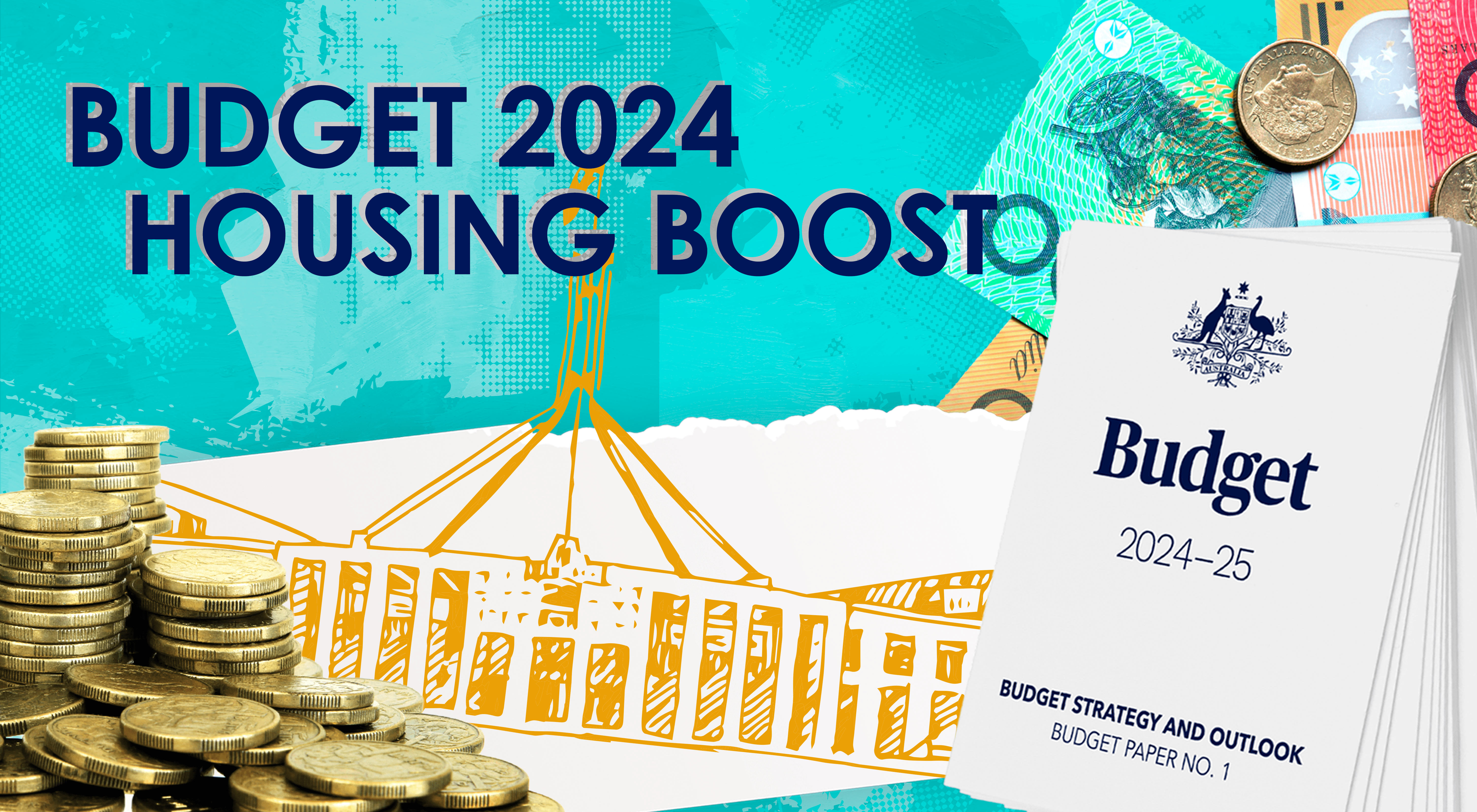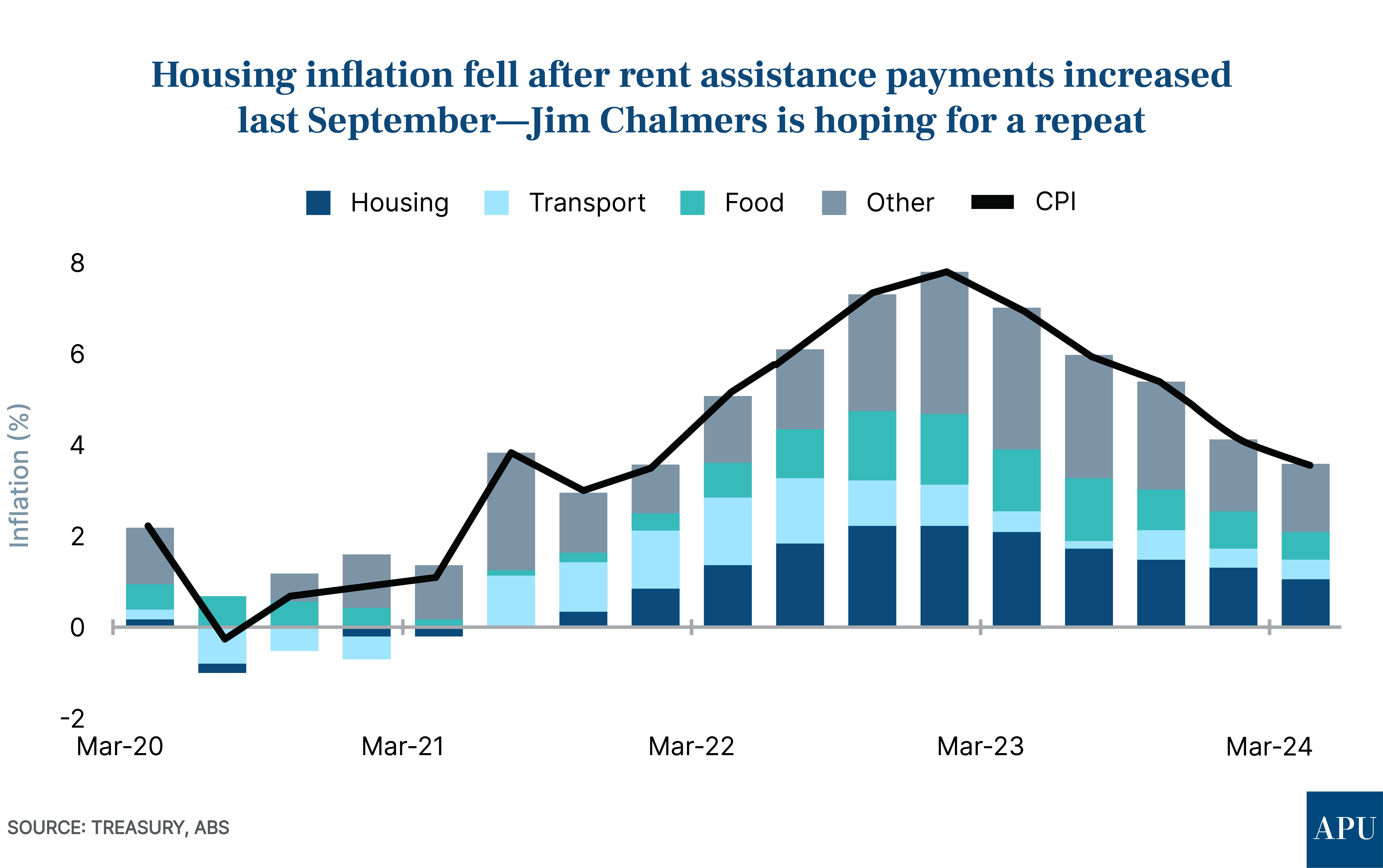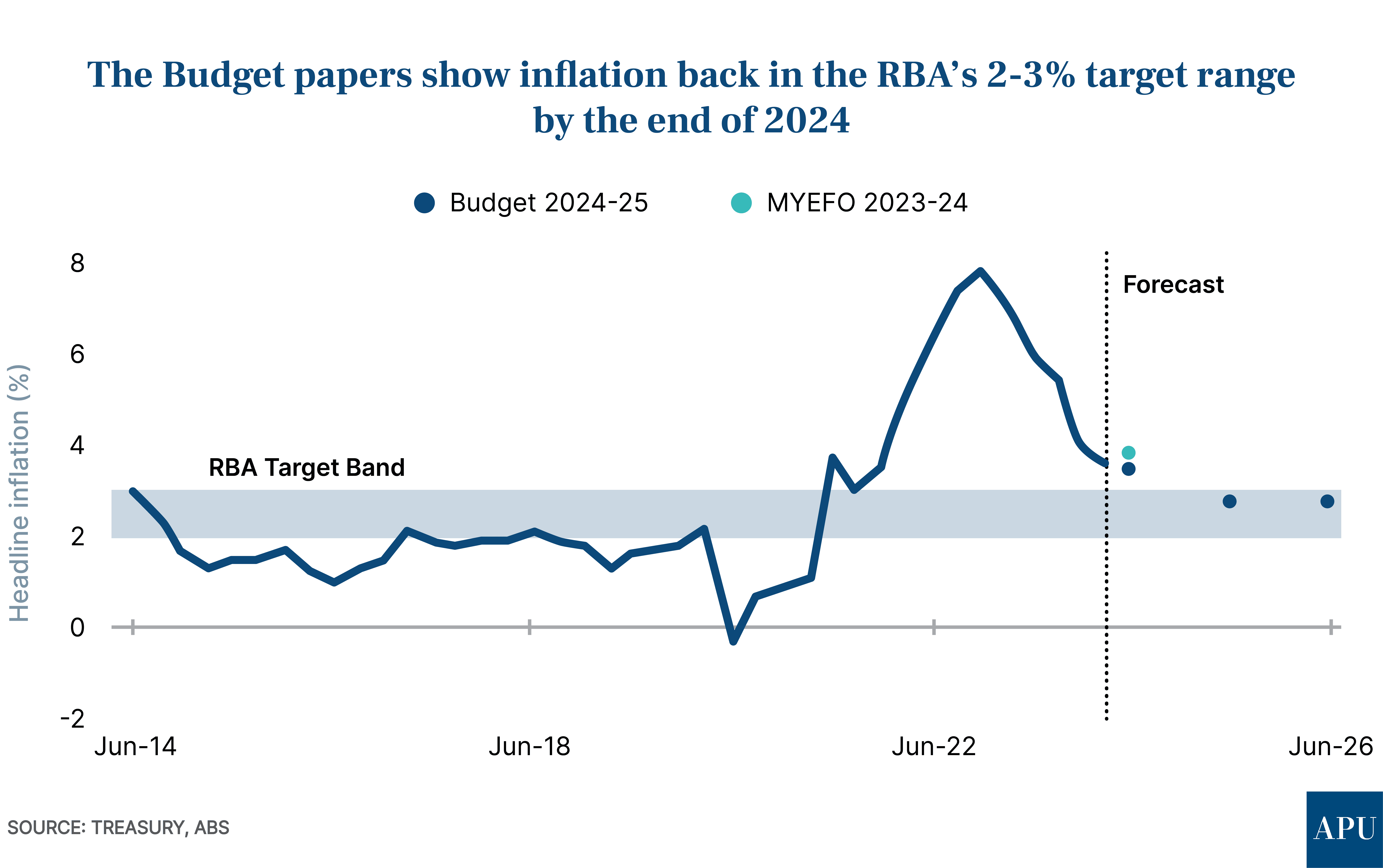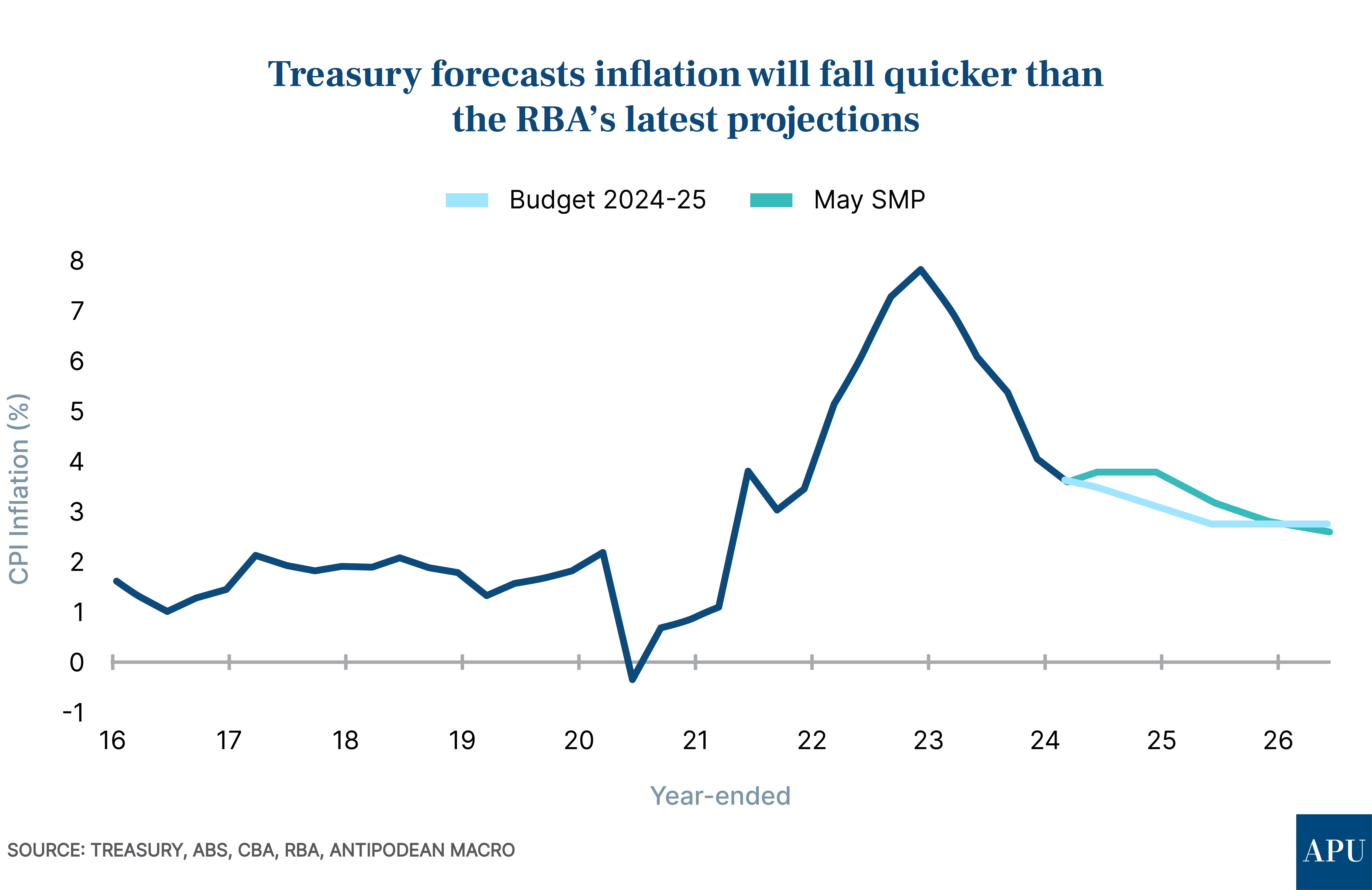Features > Property News & Insights > Financial Advice
Budget 2024 - housing boost and the inflation gamble

KEY POINTS
- There are a number of large housing measures in the Federal Budget, aimed mainly at low-income earners
- The budget will see another big increase in Commonwealth Rent Assistance, which the government says will see nearly 1 million households—around one-quarter of all renters—receiving the maximum rate of payment
- Treasury believes the rise in rent assistance and a $300 energy rebate for all households will actually help bring down inflation quicker—leading to earlier interest cuts by the Reserve Bank
- Treasury’s official inflation forecasts are now at odds with the Reserve Bank’s
As I predicted, the Albanese Labor government has put housing front and centre in this week’s national budget.
It’s a recognition of probably the biggest cost of living challenge facing many at the moment, particularly less well-off Australians dealing with soaring rents.
The danger is that much of Treasurer Jim Chalmers' good work could be undone if a gamble on inflation goes the wrong way and his large cost-of-living relief measures end up pushing out the timeline for any interest rate relief from the Reserve Bank of Australia (RBA).
Housing specifics
The Budget papers detail spending of a further $6.2 billion towards a number of housing initiatives, primarily aimed at encouraging social housing.
Treasurer Jim Chalmers is also making available a further $1 billion to the states and territories to deliver the infrastructure that supports new housing, including connecting and upgrading essential services like water, power, sewerage and new roads.
Another key measure is a $1.9 billion investment to increase the maximum rate of CRA by 10% to further alleviate rental stress.
This is in addition to a 15% increase last September, bringing the increase in CRA maximum rates to over 40% since May 2022.
Treasury estimates nearly 1 million households will now receive the maximum rate of CRA—or around one-quarter of all renters.
For example, a low-income couple with one or two children will have their rental assistance payment rise by about $22 to $243 per fortnight, while the maximum payment for a single person will increase by about $19 to $207.
This will provide lower-income Australians with some much needed relief at a time of strong rental growth, and should also help slow the housing inflation component of the Australian Bureau of Statistics’ CPI figures.

“The further increase to Commonwealth Rent Assistance will continue to provide some relief to private rental households in housing stress,” says Emma Greenhalgh, the CEO of the housing lobby group, National Shelter.
And why are so many lower-income Australians renting in the private market?
This is largely because of the dire state of public housing in this country, which is run by the states and territories.
The Budget does include funding for a new five‑year, National Agreement on Social Housing and Homelessness with the states and territories.
The deal is worth $9.3 billion, but the budget papers reveal this represents an increase of just $423 million in new funding.
The Commonwealth says it will also double dedicated funding for homelessness services to $400 million a year, but only on the condition that the states and territories match the funding.
There’s also a $1 billion increase to the National Housing Infrastructure Facility to better support housing for women and children experiencing domestic violence and for youth.
All these initiatives should be welcomed.
However, they’re to be largely delivered by state and territory governments who, to be frank, don’t have a great housing track record.
According to Ray White Chief Economist Nerida Conisbee, in the 25 years to 2021, 53,000 state and territory-run public housing properties disappeared, while private investors provided an additional 1.1 million rental properties.
The Property Council of Australia says the government’s continued focus on housing is welcome.
“This Budget contains solid investment in housing—particularly for the most vulnerable—and the better planning of our cities,” according to the Council’s CEO, Mike Zorbas.
The bigger housing picture
Given that the overwhelming majority of rental housing in Australia is provided by private “Mum and Dad” investors, I’d argue that the biggest housing initiative we’ll actually see this year will be the modified Stage 3 tax cuts, which will see an average tax cut of $36 a week from July the 1st.
When coupled with the power bill relief of $300 going to every household, and expected interest rate cuts from the Reserve Bank over the next 12 months, this should give more Australians the opportunity to either buy their own home or purchase an investment property.
Expected interest rate cuts are also expected to boost housing supply more generally.
Modelling by the Real Estate Institute of Australia shows a 50 basis point fall in rates (or 0.5% drop) would boost net housing supply by 54,000 dwellings—just what we need at the time of a severe housing shortage.
The inflation challenge
I say “expected interest rate cuts” because there is a chance this could all go horribly wrong. Jim Chalmers’ cost-of-living measures and big spending in other areas may actually end up stalling the decline in Australia’s inflation rate, even prompting the RBA to hike rates for a 14th straight time since May 20, 2024.

The RBA has stated inflation must be back in its target range of 2-3% by the end of next year.
Treasury believes inflation will be in that range by the end of THIS year.
Part of this comes down to the way Treasury calculates how the budget's targeted cost-of-living measures will impact inflation.
“As flagged by the Treasurer before the Budget was released, Treasury’s headline inflation forecasts are lower than the RBA’s,” says Antipodean Macro’s Justin Fabo.
“This is largely because Treasury has incorporated new energy bill relief and rent assistance from the Federal Government into its numbers.
“Treasury expects the energy bill relief and Commonwealth Rent Assistance to directly reduce inflation by ½% in 2024–25,” the former central banker-turned-analyst says.
The danger is that Australians could spend any savings they receive through the cost of living rebates.
Justin Fabo has produced the chart below to show the difference between the Reserve Bank’s current expectations of the path of inflation in Australia, outlined in its latest Statement of Monetary Policy (SMP), versus the Treasury’s budget forecasts.

Let’s just hope the government’s cost-of-living measures don’t add to inflation, and let’s hope the Treasury's inflation forecasts—which have inflation coming down quicker and interest rate cuts probably arriving sooner—are right, not the RBA’s more gloomy ones.
Stay Up to Date
with the Latest Australian Property News, Insights & Education.




.png?width=292&height=292&name=Copy%20Link%20(1).png)
 SIGN UP FOR FREE NEWSLETTER
SIGN UP FOR FREE NEWSLETTER


.png)





.jpg?width=1920&height=1080&name=Warning%2c%20You%20Might%20Be%20Facing%20Higher%20Taxes%20Soon%20(1).jpg)





.png?width=1920&height=1080&name=Rate%20Drops%20Signal%20BIGGEST%20Property%20Boom%20in%20DECADES%20(1).png)

.jpg?width=1920&height=1080&name=Labor%20vs%20Liberal%20These%20Housing%20Policies%20Could%20Change%20the%20Property%20Market%20Forever%20(1).jpg)
.jpg?width=1920&height=1080&name=QLD%20Slashes%20Stamp%20Duty%20Big%20News%20for%20Investors%20%26%20Home%20Buyers%20(1).jpg)
.jpg?width=1920&height=1080&name=Trump%20Just%20Slapped%20Tariffs%20%E2%80%93%20Here%E2%80%99s%20What%20It%20Means%20for%20Australia%20(1).jpg)
.jpg?width=1920&height=1080&name=Federal%20Budget%202025%20More%20Debt%2c%20No%20Housing%20%E2%80%93%20Here%E2%80%99s%20What%20You%20Need%20to%20Know%20(1).jpg)
.jpg?width=1920&height=1080&name=Australias%20Housing%20Crisis%20is%20about%20to%20get%20MUCH%20Worse%20(New%20Data%20Warns).jpg)
%20(1).jpg?width=1920&height=1080&name=Australias%20RENTAL%20CRISIS%20Hits%20ROCK%20BOTTOM!%20(2025%20Update)%20(1).jpg)
%20(1).png?width=1920&height=1080&name=Is%20Adelaide%20Still%20a%20Good%20Property%20Investment%20(2025%20UPDATE)%20(1).png)
.jpg?width=1920&height=1080&name=RBA%20Shocks%20with%20Rate%20Cuts!%20What%E2%80%99s%20Next%20for%20Property%20Investors%20(1).jpg)
%20(1).jpg?width=1920&height=1080&name=I%20Predict%20The%20Feb%20Rate%20Cut%20(My%20Price%20Growth%20Prediction)%20(1).jpg)
.png?width=1920&height=1080&name=Why%20Property%20Prices%20Will%20Rise%20in%202025%20Market%20Predictions%20(1).png)
.jpg?width=1920&height=1080&name=Why%20Investors%20Are%20Choosing%20Apartments%20Over%20Houses%202%20(1).jpg)
.jpg?width=1920&height=1080&name=Why%20Rate%20Cuts%20Will%20Trigger%20A%20Property%20Boom%20(1).jpg)
.jpg?width=1920&height=1080&name=Retire%20On%202Million%20With%20One%20Property%20(Using%20SMSF).jpg)
.jpg?width=1920&height=1080&name=4%20Reasons%20Why%20You%20Should%20Invest%20in%20Melbourne%20Now%20(1).jpg)
%20(1).jpg?width=1920&height=1080&name=Old%20Property%20vs%20New%20Property%20(Facts%20and%20Figures%20Revealed)%20(1).jpg)
%20(1).jpg?width=1920&height=1080&name=Will%20The%20New%20QLD%20Govt%20Create%20a%20Property%20Boom%20or%20Bust%20(My%20Prediction)%20(1).jpg)
%20Scott%20Kuru%20(1).jpg?width=1920&height=1080&name=Inflation%20Hits%20Three-Year%20Low%20(Will%20RBA%20Cut%20Rates%20Soon)%20Scott%20Kuru%20(1).jpg)
.jpg?width=1920&height=1080&name=How%20to%20Buy%20Investment%20Property%20Through%20SMSF_%20The%20Ultimate%20Guide%20(1).jpg)
.jpg?width=1920&height=1080&name=Victoria%20Slashes%20Stamp%20Duty%20Melbourne%20Set%20to%20Boom%20Scott%20Kuru%20(1).jpg)
.png?width=1571&height=861&name=Are%20Foreign%20Buyers%20Really%20Driving%20Up%20Australian%20Property%20Prices%20(1).png)
.jpg?width=1920&height=1080&name=The%20Single%20Factor%20That%20Predicts%20Property%20Growth%20Regions%20(1).jpg)
%20Scott%20Kuru%20(1).jpg?width=1920&height=1080&name=My%20Prediction%20On%20Rates%20%26%20Negative%20Gearing%20(Market%20Crash)%20Scott%20Kuru%20(1).jpg)

-1.png?width=1920&height=1080&name=Major%20Banks%20Cut%20Rates%20Will%20RBA%20Follow%20Suit%20(Sept%20Rate%20Update)-1.png)
%20Scott%20Kuru-1.png?width=1920&height=1080&name=Rate%20Cut%20Coming%20What%20New%20Zealands%20Move%20Means%20for%20Australia%20(Sept%20Prediction)%20Scott%20Kuru-1.png)
%20(1).jpg?width=1920&height=1080&name=Buy%20when%20the%20interest%20rates%20are%20high!%20(Why%20you%20must%20buy%20now!)%20(1).jpg)
.jpg?width=1920&height=1080&name=Carms_Revised%20Taxes%20Due%20Aug%209%20YT%20Thumbnail02%20(1).jpg)
.jpg?width=1920&height=1080&name=Carms_Too%20Little%20Too%20Late%20Aug%207%20YT%20Thumbnail01%20(1).jpg)









.jpg?width=1920&height=1080&name=Carms_Rate%20Drop%20In%20July%20Jun%2010%20YT%20Thumbnail02%20(1).jpg)
.jpg?width=1920&height=1080&name=Carms_Own%20a%20Property%20V6%20Jun%205_YT%20Thumbnail%20(1).jpg)









.png?width=1920&height=1080&name=Artboard%201%20(3).png)






.jpg?width=1920&height=1080&name=YT%20thumbnail%20%20(1).jpg)

